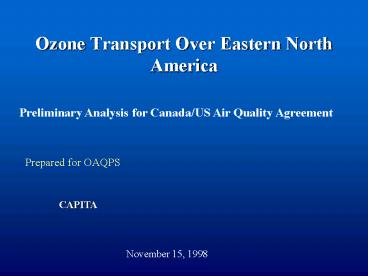Ozone Transport Over Eastern North America - PowerPoint PPT Presentation
1 / 9
Title:
Ozone Transport Over Eastern North America
Description:
Data can be obtained from: http://capita.wustl.edu/datawarehouse ... At many sites, the avg. O3 is higher when the wind blows from the center of the Eastern US. ... – PowerPoint PPT presentation
Number of Views:96
Avg rating:3.0/5.0
Title: Ozone Transport Over Eastern North America
1
Ozone Transport Over Eastern North America
Preliminary Analysis for Canada/US Air Quality
Agreement
Prepared for OAQPS
CAPITA
November 15, 1998
2
Locations of ozone and surface wind monitoring
sites
The ozone data set (1986-1996) consists of 670
Eastern US and 130 Canadian sites from 7 networks
including EPA's AIRS and Canada's NAPS. Data can
be obtained from http//capita.wustl.edu/dataware
house/datasets/capita/NamO3DayMx/NamO3DayMx.html
3
At slow wind speeds, lt 3 m/s, O3 concentrations
tends to be somewhat higher just downwind of the
urban areas. The average concentrations are
highest near metropolitan areas.
4
At high wind speeds, gt 6 m/s, higher
concentrations appear at the downwind edges of
the Eastern North American domain.
5
In the South, higher winds reduce O3, in the
North it does not.
Relative change of ozone concentration with wind
speed.
6
In urban Toronto, southwesterly flow yields
constant ozone while northerly winds show
decreasing ozone.
Change of ozone concentration with wind speed and
direction.
7
At many sites, the avg. O3 is higher when the
wind blows from the center of the Eastern
US.Higher O3 at Toronto occurs with southerly
winds.
Ozone roses for selected 100 mile size
sub-regions.
8
On high O3 days, the transport winds are slow
with clockwise circulation around the
south-center of the Eastern US.On low O3 days,
swift transport winds are from outside the
industrial Eastern North America.
Transport winds during high (90-ile) local ozone
days.
Transport winds during low (10-ile) local ozone
days.
9
Planned O3 Analysis for Eastern North
AmericaDecember 98 - April 99
- Spatial and temporal ozone pattern analysis
- Spatial patterns of O3 averages and percentiles
- Spatial and temporal pattern of exceedances
- Weekly and seasonal cycles
- Transport analysis
- O3 as a function of 3D (upper air) winds.
- 3D transport as a function of O3 concentrations
- O3 as a function of surface winds including
Canadian winds - Trajectory residence time analyses
- Web site for Canada/US science interaction
- Review and inclusion of past analyses































